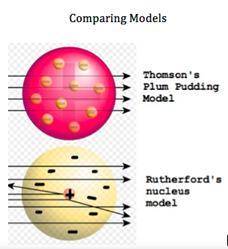
Physics, 29.01.2021 06:40 gustavoroggero39
Atomic models have changed over the decades. Two early atomic models can be seen here. There is a dramatic change in the models, as Rutherford experimented with the cathode ray tube and charged particles. Differentiate between the two models by selecting the main difference between the models.
Question 5 options:
Rutherford's model shows negative charges dispersed throughout the atom
Rutherford's model shows negative particles orbiting the central nucleus
Rutherford's model shows the positive charge of an atom as a very small area
Thomson's model shows at sea of negative charged particles surrounding a small, positive area


Answers: 2
Another question on Physics

Physics, 22.06.2019 14:30
Lightning is an example of what phenomenon? a release of a large amount of energyan absorption of a large amount of energya natural electric circuita natural electric current
Answers: 1

Physics, 23.06.2019 01:00
When solid surfaces slide over each other the kind of friction that occurs is called friction
Answers: 2

Physics, 23.06.2019 02:50
You are still fascinated by the process of inkjet printing, as described in the opening storyline for this chapter. you convince your father to take you to his manufacturing facility to see the machines that print expiration dates on eggs. you strike up a conversation with the technician operating the machine. he tells you that the ink drops are created using a piezoelectric crystal, acoustic waves, and the plateau-rayleigh instability, which creates uniform drops of mass m = 1.25 ✕ 10−8 g. while you don't understand the fancy words, you do recognize mass! the technician also tells you that the drops are charged to a controllable value of q and then projected vertically downward between parallel deflecting plates at a constant terminal speed of 20.0 m/s. the plates are ℓ = 2.15 cm long and have a uniform electric field of magnitude e = 6.40 ✕ 104 n/c between them. noting your interest in the process, the technician asks you, "if the position on the egg at which the drop is to be deposited requires that its deflection at the bottom end of the plates be 0.17 mm, what is the required charge on the drop (in c)? " you quickly get to work to find the answer. (neglect the force of gravity.)
Answers: 1

Physics, 23.06.2019 18:00
An unknown mineral sample has a mass of 318 g and a volume of 120 cm³. which mineral could the sample be? a. gypsum (density = 2.3 g/cm³) b. quartz (density = 2.65 g/cm³) c. apatite (density = 3.1 g/cm³) d. zircon (density = 4.65 g/cm³)
Answers: 1
You know the right answer?
Atomic models have changed over the decades. Two early atomic models can be seen here. There is a dr...
Questions

Mathematics, 18.02.2020 22:46



English, 18.02.2020 22:46

Mathematics, 18.02.2020 22:46

Mathematics, 18.02.2020 22:47





Mathematics, 18.02.2020 22:47

Mathematics, 18.02.2020 22:47

Health, 18.02.2020 22:47



Mathematics, 18.02.2020 22:47






